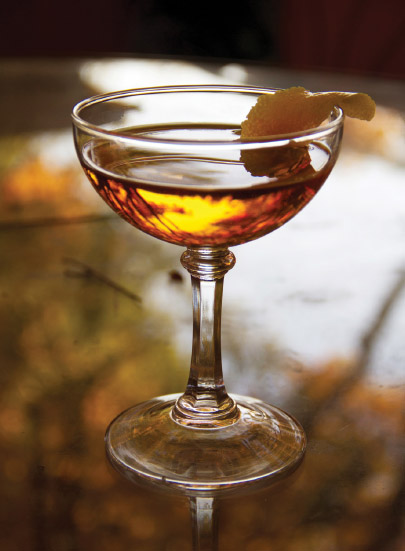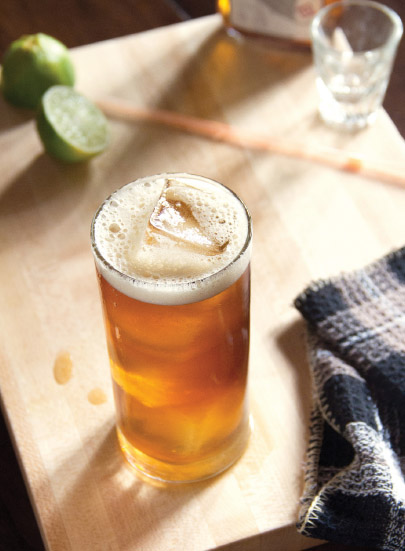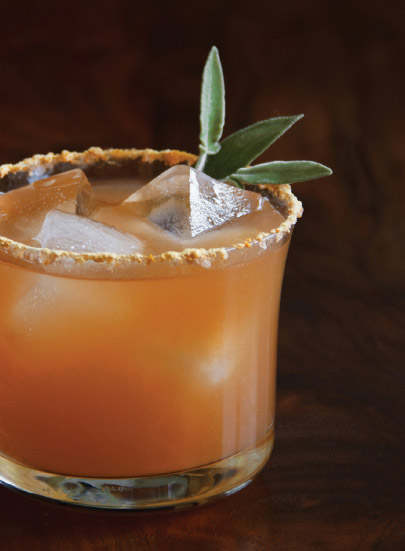
Smoky cocktails aren’t for the faint of palate, but smoldering mezcals and peaty scotches are gaining a new audience as people’s acceptance of complex flavors grows. Bartenders have noticed this trend and are incorporating sooty sensations into their bar lists in all sorts of ways, both new and traditional.
The Long Goodbye is a cocktail from Jay Porter that has an appropriately long, smoky finish. It appears on the menu of his San Diego restaurant El Take It Easy. The long finish comes from mezcal, a 100 percent agave spirit that’s gathering quite a bit of notice among the culinary set. Mezcal can be gorgeously complex and endlessly intriguing. Still, many folks are bewildered by this spirit, despite its having been dubbed “The Next Big Thing in Booze” by many writers in the spirits world. Part of the confusion stems from the fact that not all mezcal is tequila—though all tequila can be classified as mezcal. Tequila is a form of mezcal that by law can be produced only in designated areas of western Mexico.
So what, then, is mezcal? Despite its newfound fame, mezcal in the broadest sense is the precursor to tequila, much as rye is to bourbon. These days, tequila is mostly produced in large factories, and its flavor profile has been homogenized. This isn’t necessarily a bad thing—there’s something to be said for a well-made, smoothly elegant tequila—but mezcal is still mostly made by hand, by a far more humble process of distilling the agave plant. A young mezcal, known as a jovan, gains its smoky backbone when the agave is roasted in palenques, or rock-lined pits, prior to distilling. Though not typical, some mezcals are aged and become known as reposado. But Jay prefers to use a young blanco variety to show the raw essence of mezcal.

2 pony shots / 60 ml / 2 fl oz mezcal blanco
2 tbsp / 1 fl oz freshly squeezed lime juice
1 tbsp / 1/2 fl oz herbal lemon syrup, using mint (see page 14)
Combine the mezcal, lime juice, and lemon syrup in a cocktail shaker ⅔ filled with ice. Shake vigorously and strain into a chilled coupe glass.
The Autumn Ash is a modern-day scotch cocktail. Back in the days of Madison Avenue’s Mad Men–style boardrooms, scotch meant blended whiskey—that’s whiskey with an “e.” In fact, whiskey was blended to intentionally give it an air of conformity. Some brands were naturally better than others, but all were pretty much after the same prize: the loyalty of the (mostly) men who swigged the stuff as a matter of status. Over the decades, the status of blended whiskey has suffered at the peat-stained hands of very good single malt whisky—that’s whisky without the “e.” But the tables are turning once again. Blended whisky (with or without an “e”) is turning up on top shelves everywhere. It’s a terrific choice for complex, smoke-tinged savory cocktails. I love the restrained way the “smoke” in this cocktail wafts into your consciousness a millisecond after the fact.

2 pony shots / 60 ml / 2 fl oz blended scotch whisky
1 pony shot / 30 ml / 1 fl oz apple brandy
1/4 pony shot / 71/2 ml / 1/4 fl oz elderflower liqueur
2 dashes orange bitters
1 lemon twist, as garnish
Combine the scotch, apple brandy, elderflower liqueur, and bitters in a mixing glass half-filled with ice. Stir until chilled and properly diluted, about 20 seconds. Julep-strain into a chilled coupe or cocktail glass. Garnish with a lemon twist, expressing its oil onto the surface, rubbing it on the glass rim, and dropping it in, peel side up.
Makes 1
... and I mean everything.
2 slices crispy bacon, divided
1 shot / 45 ml / 1-1/2 fl oz rye
2 tbsp / 1 fl oz lime juice
1 tbsp/ 1/2 fl oz simple syrup
3 drops liquid smoke (use an eye dropper, not the shaker top on the bottle)
Crumble a piece of bacon and place it in a pint glass of a Boston shaker. Add the rye, lime juice, simple syrup, and liquid smoke. Allow the mixture to sit for about 10 minutes then strain through a paper towel into a cocktail shaker ⅔ filled with ice. Discard the solids. Cover and shake vigorously. Using a Hawthorn strainer, double-strain the cocktail through a wire-mesh sieve into a chilled cocktail glass. Lay the remaining bacon slice across the top of the glass to nibble on.
Makes 1
This is a Dan Greenbaum recipe from his bar, The Beagle, which is definitely located in New York despite all the Internet indications that it’s in Portland, Oregon. Maybe the myth came about because Dan’s partner in the place, Matt Piacentini, is a Portlander. Regardless, it may account for the fact that I often see this terrific bar referred to as The Beagle NYC.

1 (⅛-inch) slice English cucumber
1 tbsp / 1/2 fl oz freshly squeezed lime juice
1 tbsp / 1/2 fl oz TomR’s tonic syrup or other quinine syrup (available online)
1 tbsp / 1/2 fl oz ginger syrup (see page 14)
1/2 shot / 22 ml / 3/4 fl oz mezcal blanco
Negra Modelo beer, as needed
In a sturdy, thick-bottomed pint glass from a Boston shaker, use a bar muddler to crush the cucumber, lime juice, tonic syrup, and ginger syrup into a fragrant, pulpy mush. Pour in the mezcal.
Fill the metal part of the Boston shaker ⅔ full with ice. Pour the muddled mezcal mixture (including pulp) over the ice and then cap the shaker with the pint glass. Shake vigorously until well chilled. Using a Hawthorn strainer, double-strain the cocktail through a wire-mesh sieve into an ice-filled Collins glass. Fill the glass with beer and stir gently to combine. Serve with a straw.
Makes 1
This is a cocktail from Jacob Grier (see page 67). It’s made smoky with lapsang souchong tea, a black tea dried over burning pinewood.
2 pony shots / 60 ml / 2 fl oz dry gin
1-1/2 tbsp / 3/4 oz freshly squeezed lemon juice
1 tbsp / 1/2 oz yellow Chartreuse
1 tbsp / 1/2 oz lapsang souchong syrup*
1 lemon twist, as garnish
* To make the syrup, mix 1 cup freshly brewed lapsang souchong tea with 1 cup sugar until the sugar has dissolved. Makes about 1-1/4 cups. Store the extra syrup covered and refrigerated up to 1 month.
Combine the gin, lemon juice, Chartreuse, and syrup in a cocktail shaker ⅔ filled with ice. Shake vigorously. Strain into an old-fashioned glass filled with ice cubes. Garnish with the lemon twist.
Makes 1
This is my own invention, if there is such a thing. Cocktails, even the best of them, often rely on those that came before.

Peel from 1 red or pink grapefruit, roughly chopped
Water, as needed
3/4 cup sugar, divided
1 tbsp lightly crushed salt, preferably Hawaiian alaea pink salt
1/4 peeled red or pink grapefruit, cut into 4 chunks
6 large sage leaves, divided
2 pony shots / 60 ml / 2 fl oz tequila blanco
1 scant barspoon spiced syrup, using black pepper (see page 14)
1/2 pony shot / 15 ml / 1/2 fl oz mezcal reposado
1 sage sprig, as garnish
Place the oven rack in the center position and preheat the oven to 225°F. Line a baking sheet with parchment paper.
Place the grapefruit peel in a small saucepan, pour in enough water to cover, and add 1/4 cup sugar; bring to a boil. Drain off the syrup and repeat the process two more times, using all the sugar. Strain out the peels and spread them in a single layer on the lined baking sheet. Place in the preheated oven to dry completely, 2 hours or longer. Watch carefully—you want the peels to remain pink but be totally dry and crisp enough to snap. Once the peels are dried, grind them into a powder.
Mix 1 tablespoon dried grapefruit powder and the pink salt on a saucer. Moisten the rim of a double old-fashioned glass and press it into the mixture until the mixture adheres. Fill the glass with medium ice cubes; set aside.
Place the grapefruit chunks and sage leaves in a sturdy, thick-bottomed pint glass from a Boston shaker. Use a bar muddler to crush them until most of the juice is extracted—it’s okay if the grapefruit pulp is still partly intact. Pour in the tequila and spoon in the black pepper syrup. Stir lightly to combine and to remove all the syrup from the spoon.
Fill the metal part of the Boston shaker ⅔ full with ice. Pour the muddled tequila mixture (including pulp) over the ice cubes and cap the shaker with the pint glass. Shake vigorously until well chilled. Using a Hawthorn strainer, double-strain the cocktail through a wire-mesh sieve into an ice-filled old-fashioned glass. Pour the mezcal onto the drink over the back of a barspoon. Garnish with sage sprig.
Makes 1
This drink comes from Travis Owens, the talented owner/mixologist for Curio at Harvest Pizzeria in Columbus, Ohio. This drink shows real finesse in the handling of its diverse elements. The woodsy rye-driven bourbon is layered with Fernet-Branca, two kinds of vermouth, and Campari-like Luxardo Bitter—basically booze on top of booze that somehow comes together to make a well-balanced, subtly smoky cocktail.

1 shot / 45 ml / 1-1/2 fl oz bourbon
1/4 pony shot / 71/2 ml / 1/4 fl oz Fernet-Branca
1/4 pony shot / 71/2 ml / 1/4 fl oz Luxardo Bitter (or substitute Campari)
1/2 pony shot / 15 ml / 1/2 fl oz red vermouth
1/4 pony shot / 71/2 ml / 1/4 fl oz white vermouth
1/4 pony shot / 71/2 ml / 1/4 fl oz simple syrup (see page 14)
4–7 drops liquid smoke (use an eye dropper, not the shaker top on the bottle)
1 large, wide lemon peel chip, as garnish
Place 2 medium ice cubes in an old-fashioned glass. Set aside.
Combine the bourbon, Fernet-Branca, Luxardo Bitter, both vermouths, and the simple syrup in a cocktail shaker with ⅔ filled ice and shake vigorously until well chilled. Strain into the prepared glass. Garnish with the lemon chip, expressing its oil onto the surface, rubbing it onto the rim of the glass, and dropping it in, peel side up.
Makes 1
Here’s a very old drink made only with fortified wine and bitters. It is not a particularly smoky cocktail in the expected sense. But it does sit heavy on the tongue and linger. This version was adapted from Maison Premiere in Brooklyn, New York.
1 shot / 45 ml / 1-1/2 fl oz red vermouth
1 pony shot / 30 ml / 1 fl oz white vermouth
2 dashes Peychaud’s bitters or Aromatic “House” Bitters (see page 17)
2 dashes orange bitters
1 orange twist, as garnish
Fill an old-fashioned glass with ice. Build the drink by adding both vermouths and both bitters one at a time, swirling to combine. Garnish with the orange twist, expressing its oil onto the surface, rubbing it onto the rim of the glass, and dropping it in the drink, peel side up.
Makes 1
Rickey Oaxaqueña sounds like an interesting fellow. But this Rickey isn’t a Cuban bandleader; in fact, he’s not even a person. Rickey is a refreshing style of cocktail similar to a Collins or a fizz, with an obvious difference. Rickey (the drink) doesn’t traditionally include any sweeteners, instead making a powerfully sour statement. This version from Nathan Hazard stays true to that tradition and is made particularly savory with the addition of a coffee and cigarettes–inspired infused mezcal.

2 pony shots / 60 ml / 2 fl oz coffee-infused mezcal blanco (see page 19)
2 tbsp / 1 fl oz freshly squeezed lime juice
1 or 2 dashes Bittermens Xocolatl Mole Bitters (available online, optional)
1/4 to 1/8 cup / 2 to 3 fl oz club soda
1 lime wedge
Fill a highball glass with medium ice cubes. Build the drink by adding the mezcal, lime juice, and bitters (if using) one at a time to the glass. Top with club soda and stir gently. Squeeze the lime wedge over the drink, then drop it in.
Makes 1
Yeah, I know you’re laughing, but this is another serious drink from Travis Owens (see page 108).
1 shot / 45 ml / 1-1/2 fl oz mezcal blanco
1/2 shot / 22-1/2 ml / 3/4 fl oz red vermouth
1/4 pony shot / 71/2 ml / 1/4 fl oz Cocchi Americano
1/4 pony shot / 71/2 ml / 1/4 fl oz Campari
1 or 2 dashes orange bitters
Combine the mezcal, vermouth, Cocchi, Campari, and bitters in a cocktail shaker ⅔ full of ice. Shake vigorously until well chilled. Strain into a chilled coupe or cocktail glass.
Makes 1
New York bartender Sam Ross’s instant classic Penicillin Cocktail is much more comforting than its medicinal-sounding name. It embellishes the traditional healing flavors of whisky, honey, and lemon with ginger and a whiff of something smoky. The smoky aroma comes from Islay scotch whisky—renowned for its peaty, briny, and sometimes medicinal flavors, a sure antidote to chilly nights. Like the original version, mine is served on the rocks, but it can take on further curative properties when stirred into a shot of very hot, very strong tea. In which case, skip the step of shaking the ingredients with ice.
1 small chunk fresh ginger
2 pony shots / 60 ml / 2 fl oz blended scotch whisky
1 pony shot / 30 ml / 1 fl oz freshly squeezed lemon juice
1/4 pony shot / 71/2 ml / 1/4 fl oz ginger and black pepper agave syrup (see page 14)
Drizzle of Lagavulin or other Islay single malt scotch whisky
Rub the ginger along the rim of an old-fashioned glass, then drop it in. Place 2 or 3 medium ice cubes in the glass; set aside.
In a cocktail shaker ⅔ filled with medium ice cubes, combine the blended scotch, lemon juice, and agave syrup. Shake vigorously, then strain into the prepared glass. Pour in the Islay scotch over the back of a barspoon so that it floats atop the drink, creating that distinctive aroma.
Makes 1
Islay (EYE-luh) refers to an island off the coast of Scotland that produces distinctively smoky scotch whisky. The west coast of the island is one of the most appreciated areas in the world among single malt lovers. It’s here that local barley, yeast, and water are brought together to begin the process of germination, turning starch into sugar. The resulting mixture is referred to as malt. The malt is then dried with smoke and heat from peat—a mossy accumulation of partially decayed vegetation that builds up in the bogs of Islay. The burning peat halts the germination process, and the malt develops a smoky, peaty, often briny flavor. The result is made into mash, then distilled and aged by world-renowned producers such as Laphroaig, Lagavulin, and Ardberg.